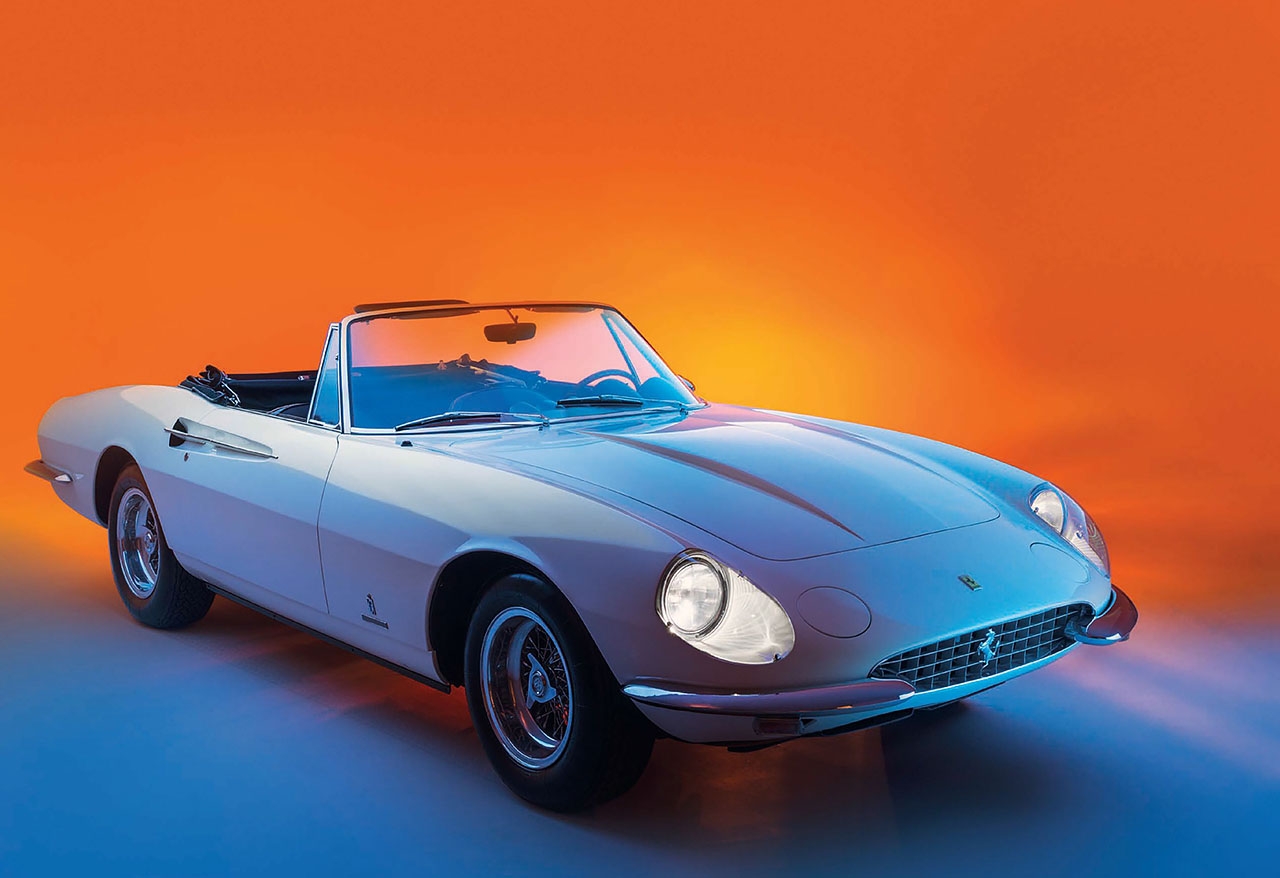
Why the Ferrari 365 California was the last in a glorious line. California dreaming Pininfarina’s fabulous Ferrari 365. As the final car in a distinguished line, the 365 California holds a special place in marque history. James Page tells the story of this distinctively styled Pininfarina rarity. Photography Tim Andrew/LAT.
The Ferrari 365 California belongs to a line of models that existed for a limited amount of time and for a very specific clientele. These were handbuilt cars that Maranello produced in tiny numbers for the superrich, people who inhabited that rarefied air in which bespoke deals were done with the utmost discretion. Used to being able to get exactly what they wanted, they would have looked at a ‘run of the mill’ 250GT or 275 and decided that they wanted something a little more special, more individual, more befitting of their status.
Introduced on the Pininfarina stand at the 1966 Geneva Salon, the 365 California appeared at the same time as the 330GTC but was, in effect, the successor to the 500 Superfast. The name, of course, traded upon the 250GT Spiders of the late 1950s and early ’60s. These Scaglietti beauties have written themselves into auction history, with a number of high-profile sales over the past decade – few more so than the ex-Alain Delon ‘barn-find’ example that Artcurial sold in Paris in 2015 for £11.8million.

Consider this, though: about 100 250GT Californias were produced in short- and longwheelbase form, but the 365 was built to the tune of only 14 cars between July 1966 and August 1967. When it was new, it didn’t benefit from being the choice of film stars or other celebrities, and in the grand scheme of the Ferrari family tree it is little more than the final point on an intriguing, indulgent offshoot.
Yet it perfectly fulfilled its brief: a large, luxurious and fast tourer for the company’s most discerning customers. When new, in fact, it was offered only to selected existing clients. Among them was property mogul Harry Hyams, who kept his for decades. Chassis 10369 was one of only two right-hookers, the other being 9985, which was delivered to a Mr Kay. Chassis 9615, meanwhile, was sold to the two sons of Rafael Trujillo, the former dictator of the Dominican Republic who had been assassinated in 1961.
But while the name evokes the 250, the bloodline of this most special of 365s can be traced back to the 340 America of 1951. Produced as a road car in miniscule quantities, that model had been fitted with Aurelio Lampredi’s V12, designed for use in Grand Prix racing but which was employed in 4101cc form for the 340.
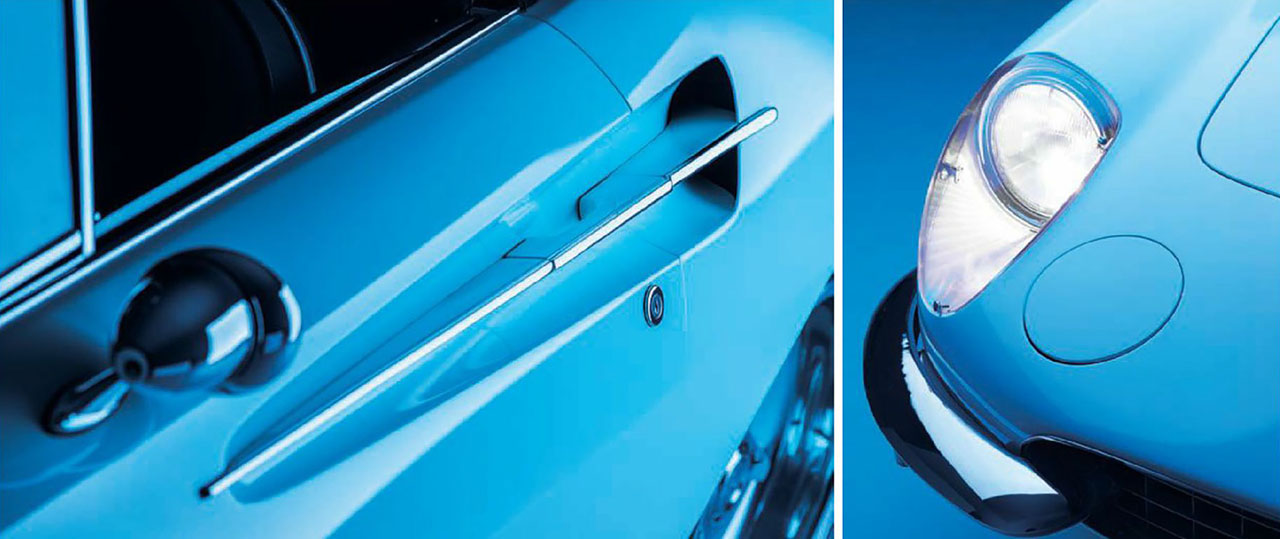
Vignale, Touring and Ghia all produced bodies for it, the last of those building a handful of fourseaters, plus a coupé for Juan Perón.
Then came the more civilised and roadorientated 342 America, of which only half a dozen were built, but they set the tone for future models. Next up was the 4522cc 375 America, which was more luxurious again and owned by the likes of Roberto Rossellini and Ingrid Bergman. When the car was introduced as a Pinin Farina 2+2 at the 1953 Paris Salon, John Bolster wrote in Autosport that: ‘Of the continental high-performance cars, none was more desirable than the new 4.5 Ferrari.’
Two years after that, the 410 Superamerica was introduced. The Lampredi V12 was stretched to 4962cc, and if you wanted one of the 14 Series 1 cars that were built you’d have had to pay half as much again as a 250GT. The 410 would last through two further incarnations until 1959, and the styling on some of the later Pininfarina bodies hinted at what was to come.

Clockwise: angles at rear evoke Fiat 124 Spider; circular pop-up lamps; strakes feature brilliant doorhandles; bare shell during restoration; interior was completely stripped; as bought by Kontes in the late 1980s; on display at Ferrari Club concours, post-rebuild.
‘DESIGNER TOM TJAARDA LEFT PININFARINA IN 1966, WHICH MEANT THAT HE NEVER SAW THE FINAL PROTOTYPE’
From when it replaced the 410 until 1964, 45 examples of the Colombo-engined 400 Superamerica were built. In 1961, Pininfarina – which had always been responsible for the majority of these tailor-made Ferraris – came up with its Aerodinamico coupé bodyshell, which boasted, among other features, a small oval grille and split front bumper. It would became pretty much standard fitment for the 400.
Its lines would echo throughout the decade, most memorably with the 275GTB and the car that would eventually supersede the 400 itself – the sublime 500 Superfast. The 36 examples of the Pininfarina-styled coupé – and it was offered as only a coupé – featured much less aesthetic variation than was evident among its predecessors, and would be sold to enthusiasts as diverse as the Shah of Iran and Peter Sellers. The 4961cc engine was unique to it, sharing the Colombo construction method but the Lampredi cylinder spacing. With a body that was cleaner and lessfussy than the 400 Aerodinamico, for many it is among the most beautiful Ferraris ever made.
Following it would therefore be a challenge for any stylist. The man entrusted with attempting just that was Tom Tjaarda. He left Pininfarina in mid-1966, which meant that he never saw the finished prototype of the 365 California, but he does retain a clear memory from the following summer. While sitting outside a café in Santa Margherita Ligure on Italy’s north-western coastline, a 365 drove past and he remembers how it captured the attention of bystanders. He remembers, too, that there was a Fiat 124 Spider parked nearby, and how his companions expressed disbelief that they were both his work.
Tjaarda penned them at roughly the same time, which is interesting because of some marked similarities between the two. At the front, the 365 retained many of the characteristics of the 500 and 400, with its elongated nose, delicate grille and split bumpers. Flip-up lights, operated via a switch hidden beneath the dashboard, complement the covered headlamps, and the immense sweep of bonnet presents everything that you’d expect of a glamorous 1960s Ferrari.
The rear, however, was a serious departure from what had gone before. Upright and angular, it evokes the Fiat’s tail in the way that the outer extremities seem to have been pinched upwards like Jack Nicholson’s eyebrows. Large orange reflectors dominate the view, and from here it looks like a completely different car. It is to Tjaarda’s credit that, if you take a step sideways so that you can appreciate the rise and fall of the rear arches as they sweep forward, the whole thing starts to come together once more. What cannot be denied is the 365’s sheer presence.
Large and imposing, it features a number of striking details that further help it to stand out from the crowd, from those pop-up lamps to the side scoops. Inspired by Pininfarina’s 1965 Dino prototype and repeated on everything from the 308 to the F40, they almost invisibly incorporate neat doorhandles that feature an exquisite pullaction.
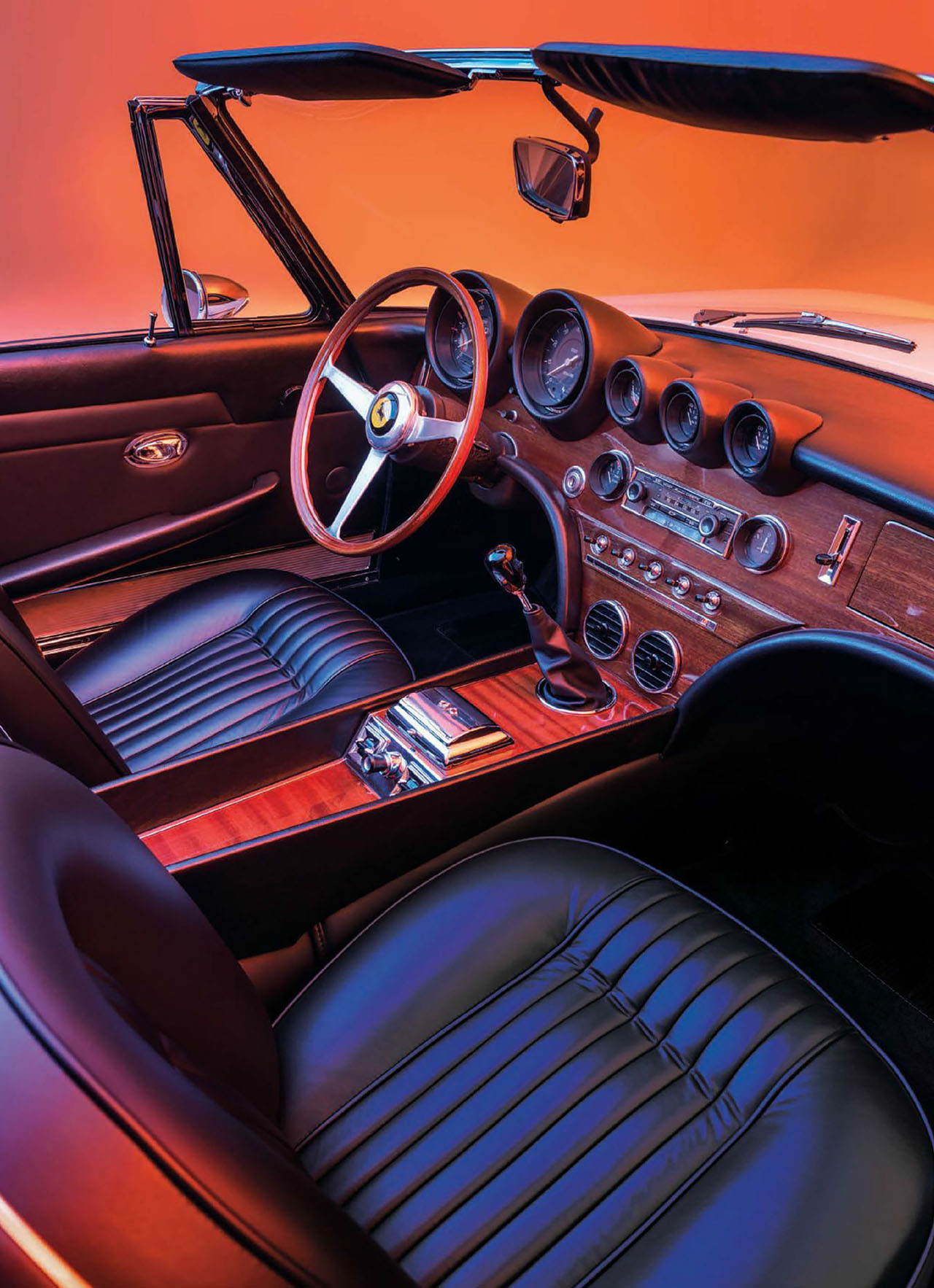
Wood-rimmed wheel and cowled instruments make for an attractive interior. Note the vents low on the centre console – aircon was fitted as standard.
At first, they look a little out of place – in one period report, they were simply referred to as ‘unusual grooves in the sides’ – and they certainly don’t provide the cooling function necessary on the mid-engined models. Even if their purpose is aesthetic rather than functional, they do serve to effectively break up the long profile, with its extended extremities.
Then there are the anachronistic Borrani wire wheels. These had been replaced on Ferrari’s mainstream models by steels or alloys by the time the 365 was produced, but they were standard fitment on the California and suit it well. Inside, everything is as beautifully finished as you’d expect, with leather and wood to the fore. The dashboard is dominated by plate-sized rev counter and speedometer, with the gauges for oil pressure and temperature, plus water temperature, arranged to the right. Three delicate stalks on the steering column control the lights, wipers and indicators, while a row of toggle switches runs across the centre console.
Even if the handbrake is an uncomfortable stretch away on the right-hand side of the driver’s footwell, it’s an exquisite cabin, and while one report from Geneva suggested that the rear seats were a mere flippery, they are reasonably generous and far from being token efforts. You’d expect nothing less considering the car’s extreme length (16ft 2in, with a wheelbase of 8ft 8in), although the bonnet and boot do account for most of that. The mohair hood folds out of the way easily and stylishly, leaving clean lines even with no tonneau cover in place.
Beneath all of that grace and luxury, the 365 used a chassis based upon that of the 500 and the 330GT 2+2. There were double wishbones at the front plus a live-axle rear, and, rather than employ the 275-style transaxle layout, the fivespeed, all-synchromesh gearbox was hung off the back of the engine. Braking was handled by servo-assisted discs all round.
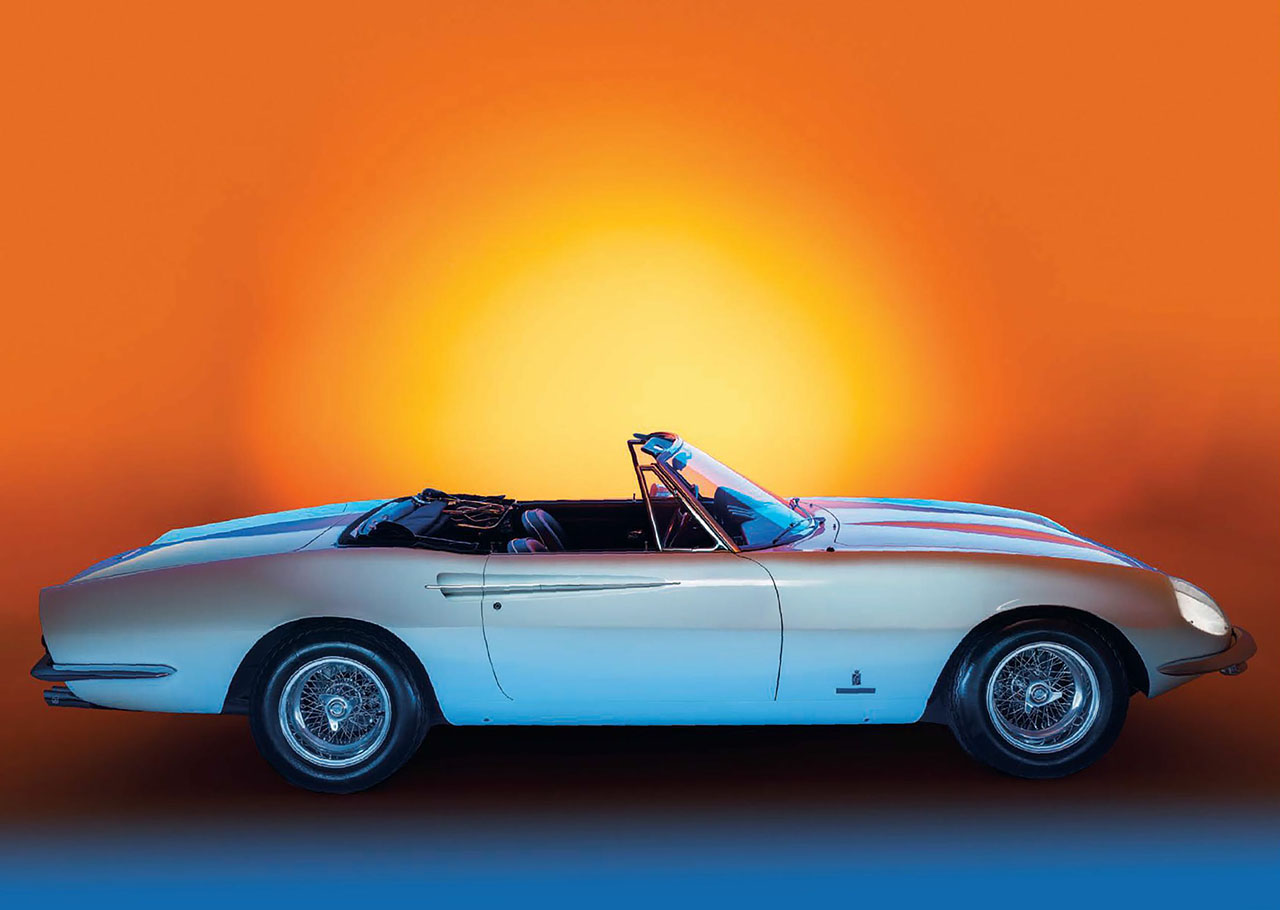
The California’s powerplant was the first roadgoing 365 unit. The 4390cc V12 featured a single camshaft per bank – a quad-cam derivative would be fitted in the Daytona – and shared the bore (81mm) and stroke (71mm) of the midengined 365P racer. With a trio of Weber downdraft carburettors, it produced 320bhp at 6600rpm. Although a car as exclusive as this would never be subjected to anything as vulgar as an official road test, the top speed was estimated as being 150mph, with the 0-60mph sprint dispatched in the region of 6 secs.
This is a car for stretching its legs on open roads rather than hustling. With its power steering and relatively soft set-up, there are those who have unkindly dubbed it ‘the Queen Mary of Ferraris’. No less an authority than racing driver and Maranello Concessionaires stalwart Mike Salmon disagreed, stating that: “The 365 California drives exceptionally well and is spectacular to look at.”
Our featured example was the seventh car built, chassis 9849 originally being delivered to William Bickel via Luigi Chinetti’s New York agency. Bickel was a marque enthusiast who also owned a 1964 250GT Lusso that was a concours winner at Ferrari Club of America events.
It then passed through numerous owners – one of whom kept it for only three months in 1971 – until, at some point between 1972 and ’74, it was repainted burgundy. At the same time, the power steering mechanism and pop-up headlamps were removed and stored in the boot.
It even acquired 512BB tail-lights at one stage, before William Kontes acquired it for $225,000 in 1989, by which time the car was red.
A lengthy rebuild was started, with the work being entrusted to noted specialist Michael Regalia. It does not seem to have been the smoothest of processes. On 11 June 1991, Kontes wrote to Regalia to say that: ‘As we have discussed at length, the 365 California restoration project has missed three important completion dates… I am relying on you to give this project the priority it deserves at this time.’
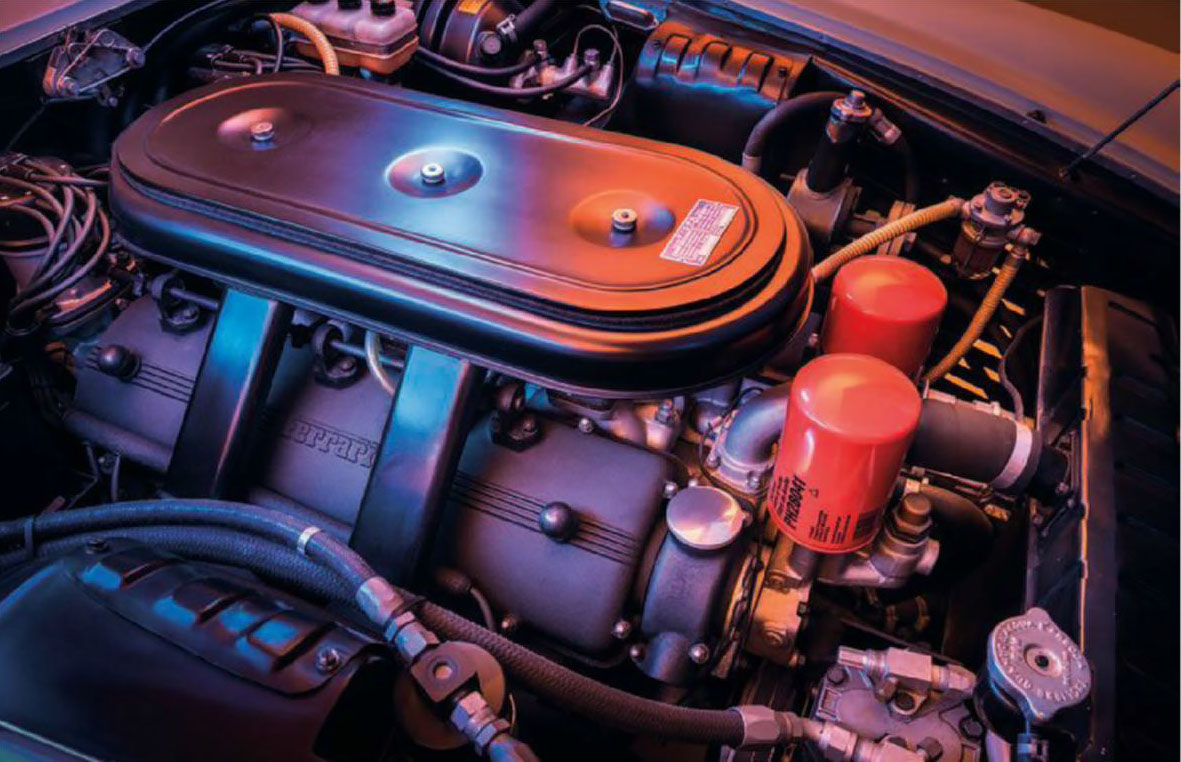
After some confusion about a meeting that apparently should have taken place on 24 August 1992, a further communication tersely stated: ‘Please be advised that I am terminating this project. The pattern of poor communication… can no longer be tolerated.’
Fortunately, the differences between the two parties seem to have been resolved because the invoices keep coming. Between 12 January and 4 February 1993 alone, they add up to $13,784.
Over the next three weeks, another $13,355 was added to that. Not long after came a letter advising: ‘Please note that the total to date is fast approaching the amount budgeted’, which can’t have come as a huge surprise.
After all of that, though, Regalia delivered the concours-standard rebuild that he’d promised. Throughout the 1990s, the 365 regularly picked up awards at Ferrari Club of America events, plus the likes of Pebble Beach, Amelia Island and the Cavallino Classic. Chassis 9849 eventually returned to Europe, since when it has been returned to its original colour combination of Bianco with Pelle Nera Franzi interior.
It was perhaps inevitable that this type of Ferrari couldn’t survive beyond the late 1960s. Maranello could no longer justify what was hardly a cost-effective way to work – producing a single car per month, many with detail differences. It was moving away from boutique indulgences and concentrating on what, in its terms, at least, passed for mass production.
Yet the 365 California didn’t exist in glorious isolation, and it was a long way from being an irrelevance that only the super-rich could appreciate. Quite apart from its position as the last of those big-engined bespoke Ferraris that went back to the 340 America, it belongs to a distinctive Pininfarina design family that includes rarities such as the 400 Aerodinamico and 500 Superfast, but also the more widely known 330GTC, 365GTC and 365GT 2+2. The fact that it was produced in even tinier numbers than its forebears proves that the demand for such exclusivity was no longer there. Few would argue that this was anything other than a spectacular way in which to bow out.
Thanks to Fiskens, which is offering the car for sale: 020 7584 3503; www.fiskens.com

Clockwise: side scoops help to punctuate the California’s vast length; the car it replaced – the gorgeous 500 Superfast; interior of the Geneva Salon car shows detail differences; elegant ashtray and window switches; the big V12 engine is good for 320bhp.
The modern breed
Both the Superamerica and California names have been revived in more recent times. The former was applied to a 2005 convertible version of the 5.7-litre 575 Maranello. Intended to be more practical than the 550 Barchetta that preceded it, the car featured a Revocromico hardtop. A carbonfibre frame held electrochromic glass, the opacity of which could be adjusted by the driver. Or, if they wanted to use the car as a proper convertible, the whole roof could be rotated completely out of the way – the rear window stayed in place to act as a wind deflector.
The California, meanwhile, arrived in 2008 and was Ferrari’s first front-engined V8. Intended to be a slightly less hardcore Ferrari – fully specced-up, it weighed not far short of two tons – it boasted a roof that folded away neatly into the boot, plus a 453bhp powerplant. That was upgraded first by another 30bhp, then with the 2014 arrival of the California T. With a twin-turbocharged, 560bhp V8 beneath the bonnet, this newest model can sprint from 0-60mph in only 3.6 secs.
‘IT WAS NEVER SUBJECTED TO ANYTHING AS VULGAR AS A ROAD TEST, BUT ITS TOP SPEED WAS IN THE REGION OF 150MPH’





